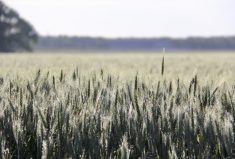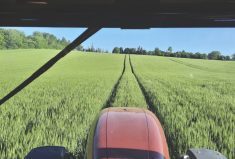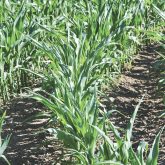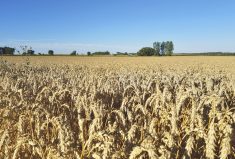In the winter of 1820, farmers at the embryonic Red River Settlement, at what is now Winnipeg, faced disaster after their seed grain was destroyed.
The colony had dabbled in wheat production for the previous few years, but with little success. It was make-or-break time for the cold-hardened and dispossessed Scotsmen who had migrated via Hudson’s Bay, following the Highland Clearances.
Late that winter they set off on snowshoes to Wisconsin to secure replacement seed, and that spring they freighted back 250 bushels in the flatboats of the day, by way of the Mississippi, Minnesota and Red rivers, arriving back just in time for sowing, and produced a “fine crop” according to the reports that year.
Read Also

Producers aren’t panicking over tariffs and trade threats
The influence of tariff and trade uncertainity on farm business decisions.
It was the first wheat harvest of any meaningful size on the Canadian Prairies, and fittingly it revealed both the challenges and rewards of farming in this isolated, climate-challenged fringe.
About 100 years later another challenge loomed in what had become one of the acknowledged breadbaskets of the world. By the 1920s wheat stem rust had become the feared disease. First identified positively in Italy in 1767, it had made the jump to the New World when wheat became a major crop on the virgin lands of the central plains.
Running riot through this near-monoculture, it took an enormous bite out of agriculture’s profitability and threatened the future of the hardy pioneer farmers.
Once again Winnipeg played a central role in this fight, with the government of the day establishing the Dominion Rust Laboratory, better known as the “Rust Lab,” in 1925 to combat rusts of all types in cereal crops.
Stem rust battle
Brent McCallum, a research scientist and plant pathologist with the federal agriculture department in Manitoba, is also president of the Canadian Phytopathological Society, the professional organization for plant pathologists.
“Stem rust was the initial focus because of the damaging nature of the disease,” McCallum explains. “Through breeding for resistance, stem rust was controlled through the 1930s and 1940s. Then the pathogen mutated and Race 15B caused more epidemics in the 1950s, which were also controlled through new cultivars such as Selkirk, Manitou, Neepawa and Katepwa.”

That encapsulates the nature of the struggle against crop diseases almost in its entirety — an ongoing struggle to stay ahead of a constantly evolving foe. It requires a special type of person, and is perhaps one of the most important and unheralded contributions to grain agriculture.
McCallum says the attraction for most of his colleagues is a chance to do interesting scientific research, the special challenge of disease and host interactions and the undeniable appeal of being able to make a tangible difference.
“It really is very interesting work, especially when you realize you’re dealing with not one, but two organisms, and how they interact together,” McCallum says. “It’s also really satisfying when you realize you’ve made a contribution to solving a problem that affects people’s livelihood.”
The process
While each challenge is unique, there is a certain methodical similarity in how the problem is approached by the research establishment whenever a new crop disease rears its ugly head.
“Accurate identification is a key first step,” McCallum says. “Provincial plant pathologists and diagnostic labs are often the first to encounter new diseases.”
Those individuals have the expertise to determine if the disease is something that’s been seen before but hasn’t been around for a few years, or if it’s something new entirely. Often the “new” diseases are actually something that’s been around in previous seasons but hasn’t really taken off.
“Then they begin to increase dramatically due to changes in weather, cropping practices or the planting of susceptible cultivars,” McCallum says.
Once the “what” has been determined, it’s time to move on to the next question — where is the disease present? That’s something that’s only reliably accomplished through field surveys, which determine how widespread the pathogen is. These two pieces are then put together and it’s time to start looking for solutions.
In some cases it may be as simple as switching to already-available varieties that carry genetic resistance to the disease. In other cases it could mean incorporating certain cultural practices into a production system, or determining what fungicides or other control products might be effective. In the most challenging cases, the disease is something for which almost no controls exist, as was the case with fusarium head blight through the 1980s and 1990s.
Team approach
It’s when this happens that one of the most important relationships in the industry bears fruit — the interaction between plant pathologist and plant breeder. Brian Rossnagel spent much of his career as a barley breeder at the Crop Development Centre at the University of Saskatchewan. He speaks admiringly of the skill set his colleagues in plant pathology bring to the table and points out that in past years, there wasn’t always a clear division between the two fields of endeavour.
“Not many people realize this, but in the 1950s and 1960s, most of the plant breeders actually came from plant pathology; that was their training,” he says. “By my day, it had switched over to plant science, which is what my background is in, and these days it’s mainly people from a molecular biology background.”
Rossnagel describes himself as “extremely fortunate” to have worked in an early job at the University of Manitoba for some of these previous generation of plant pathologists turned plant breeders.
“It was very good for me to be exposed to those ideas and that way of approaching problems,” Rossnagel says. The information from the plant pathology community gives plant breeders the basis upon which to begin looking for genetic resistance and make the appropriate crosses, shaving valuable seasons off the hunt for a cure. They also act as the eyes and ears for the industry, maintaining constant vigilance against newly developing threats.
Ongoing effort
Keeping that effort ongoing is important — but it’s often not the easiest thing to do, especially if there’s no immediate threat from any particular disease.

Take a disease like wheat stem rust, for example. It hasn’t been a major problem in many years in North America, with the last major economic losses occurring in the 1950s. But just a few years ago, in a field halfway around the world in Uganda, a new race, dubbed Ug99, was discovered. The new strain was virulent against many existing resistance genes and caused yield losses as high as 100 per cent. It was an existential threat to wheat production and global food security and could not be ignored.
Out of the public research establishment a team of plant pathologists and breeders, led by AAFC research scientist Tom Fetch out of Morden, Man., was pulled together to tackle the problem. They began by testing existing lines for resistance and susceptibility and discovered about 80 per cent were susceptible and 20 per cent offered some line of resistance — a key first response if the issue does spread out from it’s current location.
In 2014 the first wheat variety with true Ug99 resistance, AAC Tenacious, was registered by the CFIA.
Public research decline
Any outside observer would likely look at this response and judge it to be a textbook case — the distant early warning system keyed in on a problem and a solution was found before it was needed. Crisis averted. However, that masks an uncomfortable reality that increasingly public research funding is coming under pressure, and this is one area where private industry is unlikely to fill the void, Rossnagel says.
“You can’t really blame the companies, they’re commercial entities, and from a commercial perspective, there is no incentive for them to do research like this, where a market doesn’t exist,” Rossnagel says.
Unless public interest research is funded adequately through government — and decades of accumulating experience teach us that will probably be a tough sell — it’s likely going to be left to grower organizations to pick up the slack. Both Rossnagel and McCallum are quick to point out that’s already happening in some cases, and both singled out the Western Grains Research Foundation for praise for taking a forward-looking view of the importance of crop disease research. Rossnagel urged other groups to look at the model and consider adopting it.
“I just hope like hell they can find a way to work co-operatively together to make sure this is happening,” Rossnagel says.
Disappearing skills
Rossnagel says if we want to see the effects of a critical shortage of plant pathology skills, we need look no farther than Europe.
Growers there have long relied on fungicides to control disease, rather than a genetic approach. Now as European farmers grapple with growing environmental pressure to reduce chemical use of all kinds, they find they need more plant pathologists.
“They’re really struggling to find them,” Rossnagel says. “They haven’t been training them and hiring them for decades and now there’s a real shortage.”
We’re not quite there yet, but it’s a growing challenge here too, and one that McCallum acknowledges, saying the plant pathology organization he heads has long advocated more attention be paid to this growing problem.
“We’re concerned about maintaining the research capacity to effectively deal with future diseases,” he says. “As plant pathologists retire across Canada, the CPS has encouraged governments, universities and private companies to hire new and highly trained plant pathologists to continue this vital work. It’s a bit like firefighters — we don’t want to have to hire a firefighter when our house is burning down. We want them in place and well trained so that if a fire does break out they can respond and limit damage.”
















